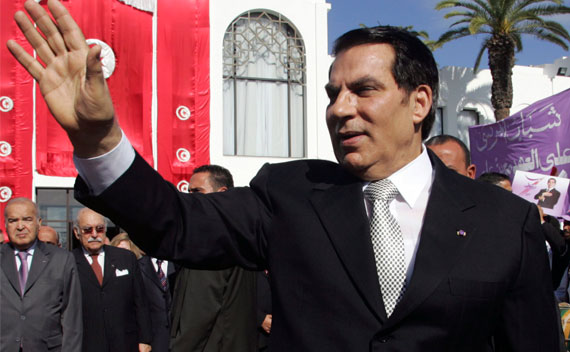The Last Days of Ben Ali?
More on:

If you don’t follow the Moor Next Door, check #Tunisia or #SidiBouzid on Twitter, or read the French Press, you would never know that there have been major demonstrations going on throughout Tunisia for the last three weeks. That’s right, Tunisia. The one Arab country with a reputation for actually working relatively well. Never mind the fact that it is one of the worst police states in the world.
Here’s what happened: In mid December an unemployed university graduate named Mohamed Bouazizi immolated himself in the Sidi Bouzid—a city of about 40,000 in the central part of the country. According to reports, Bouazizi’s had grown despondent over the lack of employment, endemic corruption, and the authoritarian political system under strongman Zine Abidine Ben Ali. Bouazizi’s act of protest and desperation produced nationwide protests that lasted through the New Year. The Tunisian government pulled out all the stops, from riot police using tear gas and rubber bullets to shutting down communications networks. At one point Sidi Bouzid was completely cut off from the world. Ben Ali also appeared on television in a speech (during which incidentally his phone rang) to rally supporters, and the regime has begun a propaganda campaign casting the protests as the product of provocateurs interested in stirring up trouble in contrast to a government holding for dialogue. Today, a high school student lit himself on fire.
I’ll leave it to others to get down in the weeds on this story, but the situation in Tunisia is in many ways instructive of the idee fixe (sorry…it’s Tunisia. I had to throw in some French) that tends to color much of what professional observers of the Arab world write and say about the Middle East. I am talking about stability. This comes out in a few ways. If you like playing the odds, stability is a pretty good bet. Take a brief tour of the region: with the exception of the Iranian revolution and America’s regime change in Iraq, Middle Eastern political systems seem quite stable and durable. This is an observable phenomenon and some pretty good explanations for the persistence of authoritarian politics in the Arab world, but there is a danger in over-stating the case and getting a bit too comfortable with the “Arab state will muddle through” argument. I recently took part in a small meeting of regional experts in which we were looking at regional political, social, and economic trends. I have written about stability in the region, but I was struck at the way some of my colleagues dismiss the potential for instability and political change in the Middle East. We should all be very careful here: Virtually everyone missed the fall of the Shah in 1979, the revolutions in Eastern and Central Europe a decade later, and the crumbling of the Soviet Union.
It may not be the last days of Ben Ali or Mubarak or any other Middle Eastern strongman, but there is clearly something going on in the region. Is it possible that the gendarme states in the region may not be a strong as we believe? To be sure, they have demonstrated flexibility and an enormous capacity to deflect and undermine opposition, but for how long? Forever? That’s a long time. We (Middle East geeks) may be doing ourselves a disservice by playing the odds-on-stability game, especially in light of the failed social contracts, Arab leaders’ willingness to employ violence against there own people, and the limited economic opportunity that led Mohamed Bouazizi to go so far as to dump gasoline over his head and light a match. A month ago, would anyone have predicted that an act like Bouazizi’s would set off major demonstrations throughout Tunisia? Events like the Duweiqa rockslide, Salam Boccacio 98 sinking, the outbreak of swine flue, and car accidents in the Gaza Strip, have the potential to become politically important well beyond the immediate issue at hand. Analysts have no way of predicting whether events like these will have a political impact or not, however. That’s why “tipping point” is not a useful analytic concept. You only know when something is a tipping point after it happens.
So how do we know that things might be unraveling in a place like Tunisia, Egypt, or Jordan (where there was rioting in Maan today)? Hard to say. Observers often look for “cracks in the regime” as a telltale sign something is up. There is another side of the equation, however. We should also be looking at society and how it organizes. If, in combination with these fissures, opposition to a regime transforms from episodic and disorganized to broad-based and coherent, that could be a sign that change is possible. The direction of that change is anyone’s guess. In June 2009, many folks thought that the Green Movement protests portended the end of the Islamic Republic, but instead we’ve observed the development of narrower, nastier dictatorship in Tehran.
It’s hard to conclude, “we’ll see,” but we’ll just have to see.
Some excellent readings on the contingent nature of political change:
Timur Kuran’s article “Now Out of Never”
Charles Kurzman’s book The Unthinkable Revolution in Iran
More on:
 Online Store
Online Store
